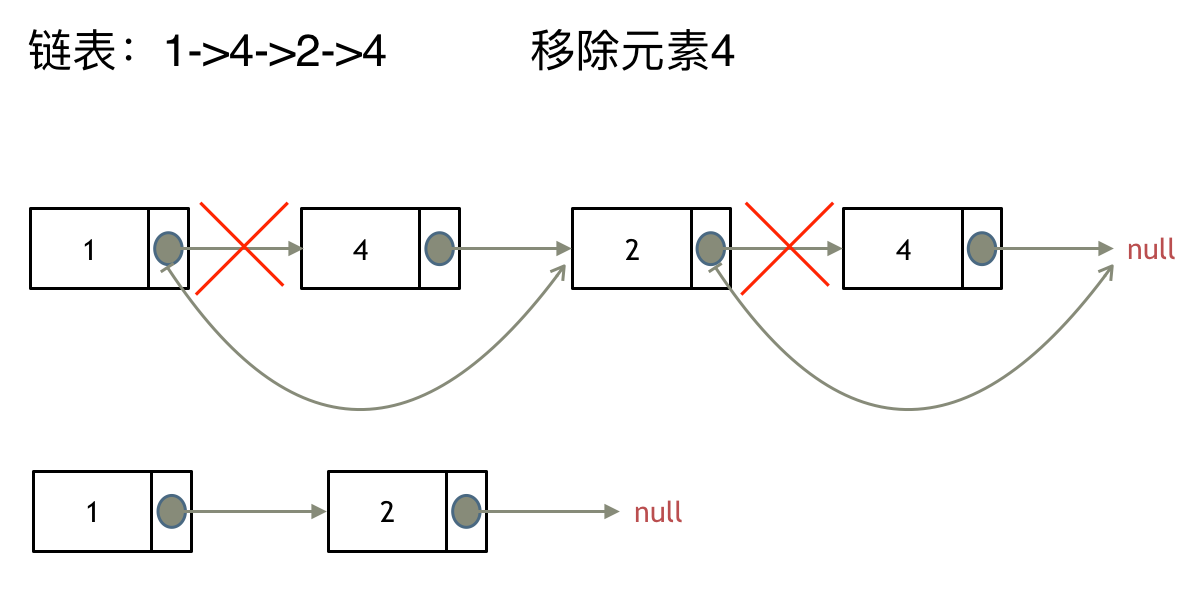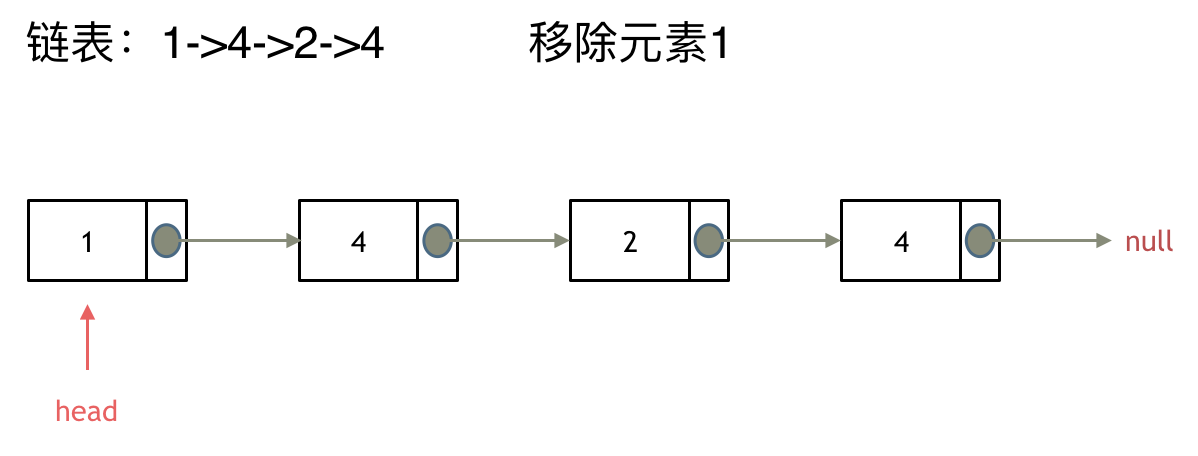参与本项目,贡献其他语言版本的代码,拥抱开源,让更多学习算法的小伙伴们收益!
链表操作中,可以使用原链表来直接进行删除操作,也可以设置一个虚拟头结点再进行删除操作,接下来看一看哪种方式更方便。
题意:删除链表中等于给定值 val 的所有节点。
示例 1: 输入:head = [1,2,6,3,4,5,6], val = 6 输出:[1,2,3,4,5]
示例 2: 输入:head = [], val = 1 输出:[]
示例 3: 输入:head = [7,7,7,7], val = 7 输出:[]
《代码随想录》算法视频公开课:链表基础操作| LeetCode:203.移除链表元素,相信结合视频再看本篇题解,更有助于大家对本题的理解。
这里以链表 1 4 2 4 来举例,移除元素4。
如果使用C,C++编程语言的话,不要忘了还要从内存中删除这两个移除的节点, 清理节点内存之后如图:
当然如果使用java ,python的话就不用手动管理内存了。
还要说明一下,就算使用C++来做leetcode,如果移除一个节点之后,没有手动在内存中删除这个节点,leetcode依然也是可以通过的,只不过,内存使用的空间大一些而已,但建议依然要养成手动清理内存的习惯。
这种情况下的移除操作,就是让节点next指针直接指向下下一个节点就可以了,
那么因为单链表的特殊性,只能指向下一个节点,刚刚删除的是链表的中第二个,和第四个节点,那么如果删除的是头结点又该怎么办呢?
这里就涉及如下链表操作的两种方式:
- 直接使用原来的链表来进行删除操作。
- 设置一个虚拟头结点在进行删除操作。
来看第一种操作:直接使用原来的链表来进行移除。
移除头结点和移除其他节点的操作是不一样的,因为链表的其他节点都是通过前一个节点来移除当前节点,而头结点没有前一个节点。
所以头结点如何移除呢,其实只要将头结点向后移动一位就可以,这样就从链表中移除了一个头结点。
这样移除了一个头结点,是不是发现,在单链表中移除头结点 和 移除其他节点的操作方式是不一样,其实在写代码的时候也会发现,需要单独写一段逻辑来处理移除头结点的情况。
那么可不可以 以一种统一的逻辑来移除 链表的节点呢。
其实可以设置一个虚拟头结点,这样原链表的所有节点就都可以按照统一的方式进行移除了。
来看看如何设置一个虚拟头。依然还是在这个链表中,移除元素1。
这里来给链表添加一个虚拟头结点为新的头结点,此时要移除这个旧头结点元素1。
这样是不是就可以使用和移除链表其他节点的方式统一了呢?
来看一下,如何移除元素1 呢,还是熟悉的方式,然后从内存中删除元素1。
最后呢在题目中,return 头结点的时候,别忘了 return dummyNode->next;, 这才是新的头结点
直接使用原来的链表来进行移除节点操作:
class Solution {
public:
ListNode* removeElements(ListNode* head, int val) {
// 删除头结点
while (head != NULL && head->val == val) { // 注意这里不是if
ListNode* tmp = head;
head = head->next;
delete tmp;
}
// 删除非头结点
ListNode* cur = head;
while (cur != NULL && cur->next!= NULL) {
if (cur->next->val == val) {
ListNode* tmp = cur->next;
cur->next = cur->next->next;
delete tmp;
} else {
cur = cur->next;
}
}
return head;
}
};- 时间复杂度: O(n)
- 空间复杂度: O(1)
设置一个虚拟头结点在进行移除节点操作:
class Solution {
public:
ListNode* removeElements(ListNode* head, int val) {
ListNode* dummyHead = new ListNode(0); // 设置一个虚拟头结点
dummyHead->next = head; // 将虚拟头结点指向head,这样方便后面做删除操作
ListNode* cur = dummyHead;
while (cur->next != NULL) {
if(cur->next->val == val) {
ListNode* tmp = cur->next;
cur->next = cur->next->next;
delete tmp;
} else {
cur = cur->next;
}
}
head = dummyHead->next;
delete dummyHead;
return head;
}
};
- 时间复杂度: O(n)
- 空间复杂度: O(1)
用原来的链表操作:
struct ListNode* removeElements(struct ListNode* head, int val){
struct ListNode* temp;
// 当头结点存在并且头结点的值等于val时
while(head && head->val == val) {
temp = head;
// 将新的头结点设置为head->next并删除原来的头结点
head = head->next;
free(temp);
}
struct ListNode *cur = head;
// 当cur存在并且cur->next存在时
// 此解法需要判断cur存在因为cur指向head。若head本身为NULL或者原链表中元素都为val的话,cur也会为NULL
while(cur && (temp = cur->next)) {
// 若cur->next的值等于val
if(temp->val == val) {
// 将cur->next设置为cur->next->next并删除cur->next
cur->next = temp->next;
free(temp);
}
// 若cur->next不等于val,则将cur后移一位
else
cur = cur->next;
}
// 返回头结点
return head;
}设置一个虚拟头结点:
/**
* Definition for singly-linked list.
* struct ListNode {
* int val;
* struct ListNode *next;
* };
*/
struct ListNode* removeElements(struct ListNode* head, int val){
typedef struct ListNode ListNode;
ListNode *shead;
shead = (ListNode *)malloc(sizeof(ListNode));
shead->next = head;
ListNode *cur = shead;
while(cur->next != NULL){
if (cur->next->val == val){
ListNode *tmp = cur->next;
cur->next = cur->next->next;
free(tmp);
}
else{
cur = cur->next;
}
}
head = shead->next;
free(shead);
return head;
}/**
* 添加虚节点方式
* 时间复杂度 O(n)
* 空间复杂度 O(1)
* @param head
* @param val
* @return
*/
public ListNode removeElements(ListNode head, int val) {
if (head == null) {
return head;
}
// 因为删除可能涉及到头节点,所以设置dummy节点,统一操作
ListNode dummy = new ListNode(-1, head);
ListNode pre = dummy;
ListNode cur = head;
while (cur != null) {
if (cur.val == val) {
pre.next = cur.next;
} else {
pre = cur;
}
cur = cur.next;
}
return dummy.next;
}
/**
* 不添加虚拟节点方式
* 时间复杂度 O(n)
* 空间复杂度 O(1)
* @param head
* @param val
* @return
*/
public ListNode removeElements(ListNode head, int val) {
while (head != null && head.val == val) {
head = head.next;
}
// 已经为null,提前退出
if (head == null) {
return head;
}
// 已确定当前head.val != val
ListNode pre = head;
ListNode cur = head.next;
while (cur != null) {
if (cur.val == val) {
pre.next = cur.next;
} else {
pre = cur;
}
cur = cur.next;
}
return head;
}
/**
* 不添加虚拟节点and pre Node方式
* 时间复杂度 O(n)
* 空间复杂度 O(1)
* @param head
* @param val
* @return
*/
public ListNode removeElements(ListNode head, int val) {
while(head!=null && head.val==val){
head = head.next;
}
ListNode curr = head;
while(curr!=null){
while(curr.next!=null && curr.next.val == val){
curr.next = curr.next.next;
}
curr = curr.next;
}
return head;
}(版本一)虚拟头节点法
# Definition for singly-linked list.
# class ListNode:
# def __init__(self, val=0, next=None):
# self.val = val
# self.next = next
class Solution:
def removeElements(self, head: Optional[ListNode], val: int) -> Optional[ListNode]:
# 创建虚拟头部节点以简化删除过程
dummy_head = ListNode(next = head)
# 遍历列表并删除值为val的节点
current = dummy_head
while current.next:
if current.next.val == val:
current.next = current.next.next
else:
current = current.next
return dummy_head.next直接使用原链表
/**
* Definition for singly-linked list.
* type ListNode struct {
* Val int
* Next *ListNode
* }
*/
func removeElements(head *ListNode, val int) *ListNode {
//依旧是先定义逻辑
//如果原链表的头节点为val的话,head=head.next,且为持续过程,防止头节点后面的节点也为Val
//这里前置循环 并且要判定head 是否为nil,防止出错
for head != nil && head.Val == val {//由于leetcode代码运行方式,for循环条件判断前后顺序不能修改,下面的for循环也同样如此
head = head.Next
}
cur := head
for cur != nil && cur.Next != nil {
if cur.Next.Val == val {
cur.Next = cur.Next.Next
} else {
cur = cur.Next
}
}
return head
}虚拟头节点方式:
/**
* Definition for singly-linked list.
* type ListNode struct {
* Val int
* Next *ListNode
* }
*/
func removeElements(head *ListNode, val int) *ListNode {
dummyHead := &ListNode{}
dummyHead.Next = head
cur := dummyHead
for cur != nil && cur.Next != nil {
if cur.Next.Val == val {
cur.Next = cur.Next.Next
} else {
cur = cur.Next
}
}
return dummyHead.Next
}/**
* @param {ListNode} head
* @param {number} val
* @return {ListNode}
*/
var removeElements = function(head, val) {
const ret = new ListNode(0, head);
let cur = ret;
while(cur.next) {
if(cur.next.val === val) {
cur.next = cur.next.next;
continue;
}
cur = cur.next;
}
return ret.next;
};版本一(在原链表上直接删除):
/**
* Definition for singly-linked list.
* class ListNode {
* val: number
* next: ListNode | null
* constructor(val?: number, next?: ListNode | null) {
* this.val = (val===undefined ? 0 : val)
* this.next = (next===undefined ? null : next)
* }
* }
*/
function removeElements(head: ListNode | null, val: number): ListNode | null {
// 删除头部节点
while (head !== null && head.val === val) {
head = head.next;
}
if (head === null) return head;
let pre: ListNode = head, cur: ListNode | null = head.next;
// 删除非头部节点
while (cur) {
if (cur.val === val) {
pre.next = cur.next;
} else {
//此处不加类型断言时:编译器会认为pre类型为ListNode, pre.next类型为ListNode | null
pre = pre.next as ListNode;
}
cur = cur.next;
}
return head;
};版本二(虚拟头节点):
function removeElements(head: ListNode | null, val: number): ListNode | null {
// 添加虚拟节点
const data = new ListNode(0, head);
let pre = data, cur = data.next;
while (cur) {
if (cur.val === val) {
pre.next = cur.next
} else {
pre = cur;
}
cur = cur.next;
}
return data.next;
};/**
* Definition for singly-linked list.
* public class ListNode {
* public var val: Int
* public var next: ListNode?
* public init() { self.val = 0; self.next = nil; }
* public init(_ val: Int) { self.val = val; self.next = nil; }
* public init(_ val: Int, _ next: ListNode?) { self.val = val; self.next = next; }
* }
*/
func removeElements(_ head: ListNode?, _ val: Int) -> ListNode? {
let dummyNode = ListNode()
dummyNode.next = head
var currentNode = dummyNode
while let curNext = currentNode.next {
if curNext.val == val {
currentNode.next = curNext.next
} else {
currentNode = curNext
}
}
return dummyNode.next
}/**
* Definition for singly-linked list.
* type ListNode struct {
* Val int
* Next *ListNode
* }
*/
// 虚拟头+双指针
func removeElements(head *ListNode, val int) *ListNode {
dummyHead := &ListNode{}
dummyHead.Next = head
pred := dummyHead
cur := head
for cur != nil {
if cur.Val == val {
pred.Next = cur.Next
} else {
pred = cur
}
cur = cur.Next
}
return dummyHead.Next
}// Definition for singly-linked list.
// #[derive(PartialEq, Eq, Clone, Debug)]
// pub struct ListNode {
// pub val: i32,
// pub next: Option<Box<ListNode>>
// }
//
// impl ListNode {
// #[inline]
// fn new(val: i32) -> Self {
// ListNode {
// next: None,
// val
// }
// }
// }
impl Solution {
pub fn remove_elements(head: Option<Box<ListNode>>, val: i32) -> Option<Box<ListNode>> {
let mut dummyHead = Box::new(ListNode::new(0));
dummyHead.next = head;
let mut cur = dummyHead.as_mut();
// 使用take()替换std::men::replace(&mut node.next, None)达到相同的效果,并且更普遍易读
while let Some(nxt) = cur.next.take() {
if nxt.val == val {
cur.next = nxt.next;
} else {
cur.next = Some(nxt);
cur = cur.next.as_mut().unwrap();
}
}
dummyHead.next
}
}/**
* Definition for singly-linked list.
* class ListNode(_x: Int = 0, _next: ListNode = null) {
* var next: ListNode = _next
* var x: Int = _x
* }
*/
object Solution {
def removeElements(head: ListNode, `val`: Int): ListNode = {
if (head == null) return head
var dummy = new ListNode(-1, head) // 定义虚拟头节点
var cur = head // cur 表示当前节点
var pre = dummy // pre 表示cur前一个节点
while (cur != null) {
if (cur.x == `val`) {
// 相等,就删除那么cur的前一个节点pre执行cur的下一个
pre.next = cur.next
} else {
// 不相等,pre就等于当前cur节点
pre = cur
}
// 向下迭代
cur = cur.next
}
// 最终返回dummy的下一个,就是链表的头
dummy.next
}
}/**
* Example:
* var li = ListNode(5)
* var v = li.`val`
* Definition for singly-linked list.
* class ListNode(var `val`: Int) {
* var next: ListNode? = null
* }
*/
class Solution {
fun removeElements(head: ListNode?, `val`: Int): ListNode? {
// 使用虚拟节点,令该节点指向head
var dummyNode = ListNode(-1)
dummyNode.next = head
// 使用cur遍历链表各个节点
var cur = dummyNode
// 判断下个节点是否为空
while (cur.next != null) {
// 符合条件,移除节点
if (cur.next.`val` == `val`) {
cur.next = cur.next.next
}
// 不符合条件,遍历下一节点
else {
cur = cur.next
}
}
// 注意:返回的不是虚拟节点
return dummyNode.next
}
}/**
* Definition for singly-linked list.
* public class ListNode {
* public int val;
* public ListNode next;
* public ListNode(int val=0, ListNode next=null) {
* this.val = val;
* this.next = next;
* }
* }
*/
public class Solution
{
public ListNode RemoveElements(ListNode head, int val)
{
ListNode dummyHead = new ListNode(0,head);
ListNode temp = dummyHead;
while(temp.next != null)
{
if(temp.next.val == val)
{
temp.next = temp.next.next;
}
else
{
temp = temp.next;
}
}
return dummyHead.next;
}
}






